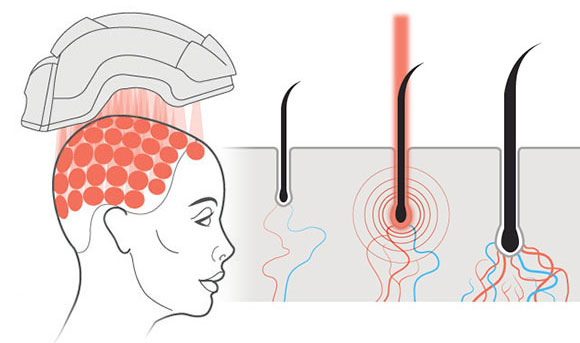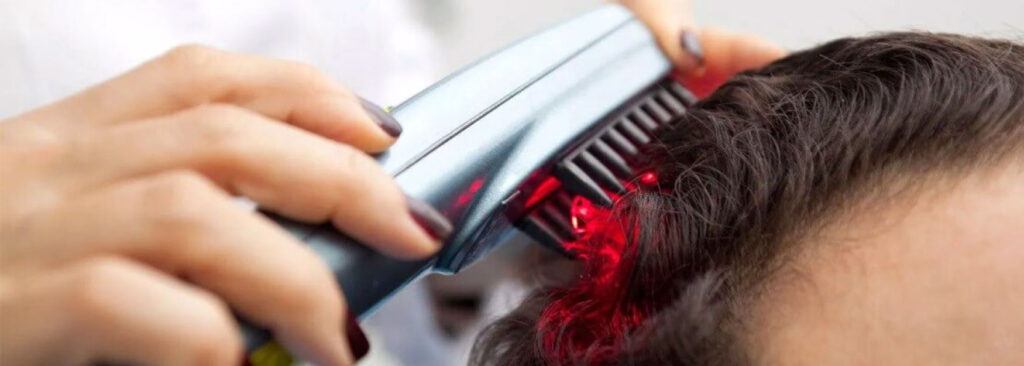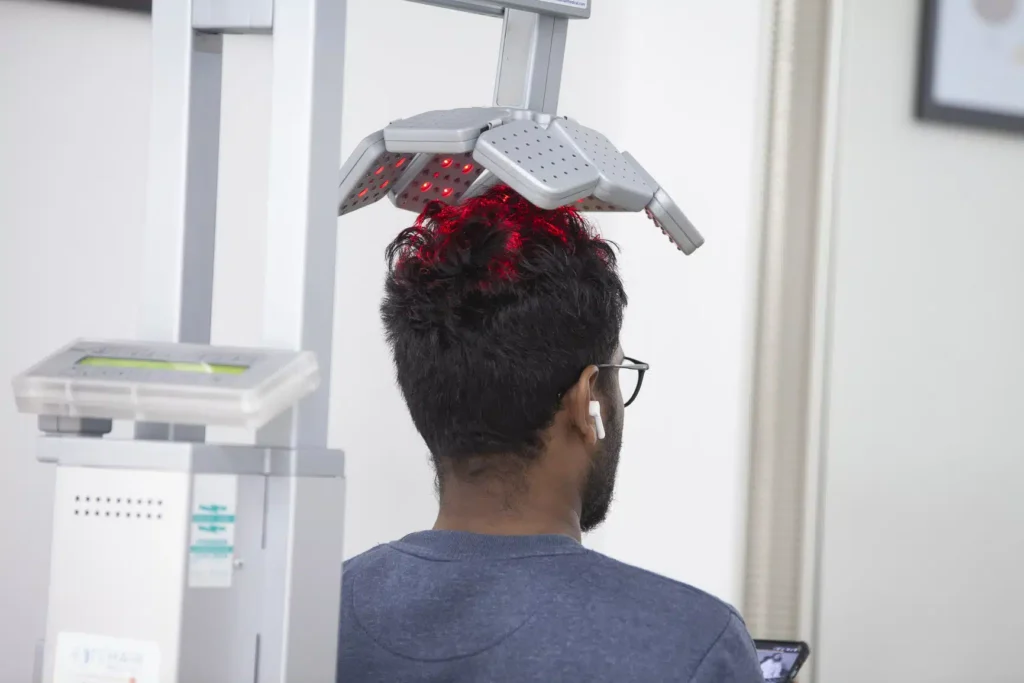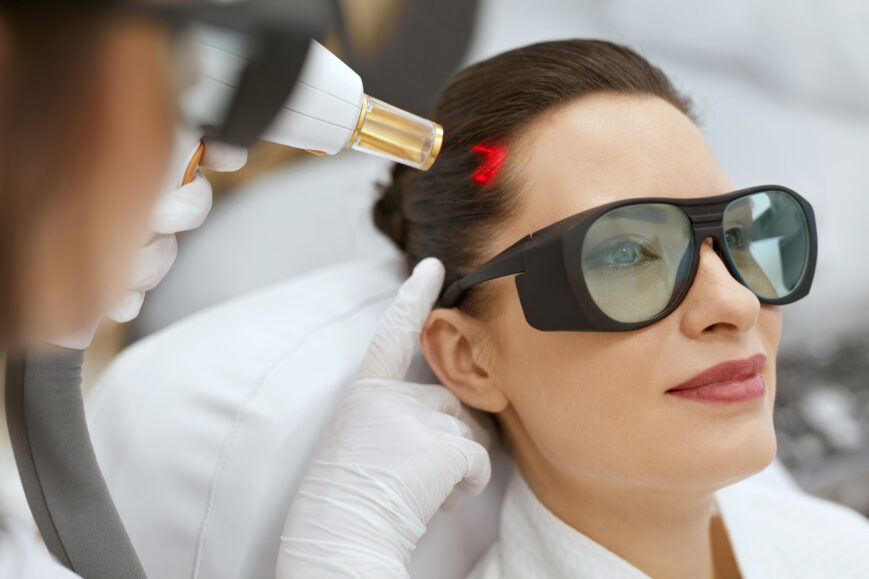Low-level laser therapy, also known as laser hair therapy (LLLT), is a noninvasive technique that stimulates hair growth by introducing photons into the scalp’s tissues. This novel method stimulates hair follicles and increases circulation, potentially relieving those losing hair.
Hair loss can be attributed to other factors, such as age, noninvasive hormonal changes, medical conditions, poor nutrition, and stress. Addressing hair loss is crucial for aesthetic reasons and the psychological well-being of someone affected by this condition.
laser hair therapy is a standard treatment for hair loss since it works well and has few adverse effects.
In contrast to hair transplants or pharmacological treatments, laser hair therapy is a less invasive option that doesn’t require surgery or medicine. Regular laser hair therapy has yielded favourable outcomes for men and women with custom baldness or thinning hair.
Home usage devices have increased the accessibility of this treatment and allowed people to easily incorporate it into their everyday routines, leading to its increasing market acceptance and popularity.
How Laser Hair Therapy Works

- Laser hair therapy, or low-level laser therapy (LLLT), uses laser light to promote hair growth. This therapy involves irradiating photons into scalp tissues, which weak cells absorb and encourage hair growth.
- Increased Blood Flow: The laser penetrates the scalp, stimulating hair follicles and promoting the hair growth cycle. This process activates cells responsible for regenerating hair follicles, leading to increased blood circulation and delivering more nutrients and oxygen to the follicles, thereby encouraging hair growth and increasing hair density.
- Strengthening Hair Follicles: Laser therapy strengthens weakened hair follicles and breaks up the build-up commonly found in the production of DHT, promoting healthier hair growth.
- Stimulation of Cellular Function: Low-level laser light stimulates cellular function through photo-biotherapy, promoting growth, repair, and healing components within the body.
Benefits of Laser Hair Therapy
How-to Guide for Laser Hair Therapy

Schedule a Consultation: Contact a reputable clinic offering laser hair therapy for an initial evaluation.
Assessment: The professional will evaluate your hair loss situation and determine whether you are a good candidate for laser therapy.
Frequency: Laser therapy sessions may need to be initially performed several times a week.
Duration: Each session typically lasts for a specific duration, as the provider recommends.
Device Selection: Choose a suitable device for at-home use or visit a clinic for professional treatment.
Proper Usage: Refer to the instructions included with the device to ensure appropriate application on the scalp.
Consistency: Maintain a regular schedule for laser therapy sessions.
Follow-up Visits: Periodic clinic appointments to assess progress and make changes to the treatment plan.
By following these steps, individuals can effectively incorporate laser hair therapy into their hair care routine, potentially experiencing improved hair growth and quality over time.
Laser hair therapy Cost
| Sessions cost | Session Cost for Full Treatment |
|---|---|
| INR 2,000 – INR 5,000 | INR 3,500 – INR 10,500 |
| $100 – $200 | $200 – $500 |
What to Expect During a Session
- Preparation:
Clean Scalp: Provide your scalp is clean and free of any effects, such as gels or sprays, that could interfere with the laser’s penetration.
Device Setup: Prepare the laser device according to the manufacturer’s instructions. This might involve charging the device or setting it to the correct mode for home-use devices.
- During the Session:
Positioning:
- Place the laser device on your scalp.
- If using a helmet-type device, wear it on your head.
- For handheld devices, move it slowly over the scalp, ensuring each area is exposed to the light.
Relax and Wait: Sit comfortably and relax while the device operates. Once positioned, most devices are hands-free, allowing you to read or watch TV during the session.
Time Management: Use a timer to ensure you adhere to the recommended duration for each session.
- Post-Session Care:
Cleaning the Device: After each session, clean the device per the manufacturer’s guidelines to maintain hygiene and longevity.
Scalp Care: There are usually no special post-session requirements, but keeping the scalp healthy with proper hydration and nutrition can enhance results.
Who Can Benefit from Laser Hair Therapy?
Ideal Candidates
Conditions Treated
Laser hair therapy is particularly effective for specific types of hair loss:
Androgenetic Alopecia (Pattern Hair Loss): This is the most common type of hair loss in both men and women, characterized by thinning hair and receding hairlines in men and diffuse thinning over the crown in women. LLLT has shown significant efficacy in treating this condition by promoting hair regrowth and increasing hair density.
Alopecia Areata: This autoimmune condition causes hair to fall out in small patches. Some studies suggest that LLLT can help stimulate hair growth in these areas, although results can vary.
Telogen Effluvium: A condition often triggered by stress, illness, or hormonal changes, resulting in temporary hair thinning. LT can accelerate recovery and promote regrowth during this phase
Pros and Cons of Laser Hair Therapy
Pros
- Noninvasive and Painless: No surgery or recovery time, making it a low-risk and comfortable treatment.
- Improves Hair Density and Thickness Stimulates hair follicles and increases blood flow, promoting thicker, denser hair.
- Safe with Minimal Side Effects Generally safe with few reported side effects, such as noninvasive scalp irritation.
- Convenient and Easy to Use Home-use devices allow easy integration into daily routines, promoting consistent treatment.
- FDA Cleared for Safety and Efficacy Devices with FDA clearance assure their safety and effectiveness.
Cons
- Varied Results Results can differ widely among individuals, with some seeing minimal improvement.
- Long-term Commitment Requires regular, ongoing sessions for several months to achieve and sustain results.
- The initial device cost is high; professional treatments and maintenance expenses are ongoing.
- It is not a Treatment for every kind of Hair loss. It is limitedly effective for other types of hair loss; it is primarily useful for androgenetic alopecia.
- It requires ongoing maintenance. Continuous use is needed to maintain benefits; stopping treatment can reverse progress.
The results from laser hair therapy (LT) for hair growth

Certainly! Here’s a breakdown of the expected results from low-level laser therapy (LLLT) for hair growth over different timeframes:
0 to 1 month:
- Initial phase with minimal visible changes.
- Reduction in hair shedding may start to occur.
- Scalp health may improve, with potential relief from itching or irritation.
2 to 3 months:
- Early signs of improvement become noticeable.
- Reduction in hair loss and increased hair thickness may be observed.
- Some individuals may notice tiny, fine hairs starting to regrow.
3 to 6 months:
- Significant improvement in hair thickness and density.
- Noticeable reduction in hair loss, leading to increased scalp coverage.
- Continued regrowth of hair in previously thinning areas.
6 to 12 months:
- Continued progress in hair growth and thickness.
- Further reduction in hair loss, with many individuals achieving their desired hair density.
- Overall improved scalp health and hair quality, resulting in thicker and fuller-looking hair.
It’s important to note that individual responses to LT may vary, and some users may experience faster or slower results depending on factors such as genetics, age, and adherence to the treatment regimen.
Alternatives to Laser Hair Therapy
Certainly! Let’s explore some alternatives to laser hair therapy and compare them with other hair loss treatments:
1. Medications (Minoxidil, Finasteride):
Minoxidil: This topical solution stimulates hair growth by widening blood vessels and opening potassium channels. Pros include its easy application and effectiveness in promoting hair growth, but cons may include scalp irritation and dependency on continued use.
Finasteride: This oral medication inhibits the conversion of testosterone into dihydrotestosterone (DHT), a hormone that shrinks hair follicles. Pros include its high success rate in preventing further hair loss and even regrowing hair, but potential side effects like decreased libido and erectile dysfunction may deter some users.
2. Hair Transplants:
Recently, those looking for hair loss treatments have been more interested in Direct Hair Implantation (DHI), a contemporary kind of FUE. In DHI, hair follicles are extracted from a donor area of the scalp and subsequently implanted in the area experiencing hair loss. This procedure is similar to FUE. Transplanting hair follicles from one area of the scalp to another is called Direct Hair Implantation (DHI) or hair transplantation. The possibility of scars, high cost, and surgical risks are potential drawbacks, but permanent results and natural-looking hair growth are pros.
3. Pros and Cons of Alternatives:
Medications offer noninvasive options with varying effectiveness and potential side effects. They require consistent, long-term use to maintain results.
Hair transplants provide a permanent solution but involve surgery, which carries inherent risks and a considerable financial investment.
Compared to LLLT, medicatnoninvasiveir transplants may offer more immediate and visible results, but they also come with higher costs and potential side effects.
While hair transplants and drugs offer varied degrees of success, permanency, and related hazards, laser hair therapy (LLLT) provides a noninvasive approach with minimal side effects and moderate effectiveness. To choose the most invasive course of action based on your needs and preferences, thoroughly consider each choice’s benefits and drawbacks and speak with a healthcare provider.
Common Side Effects:
Overall, the rare but serious risks associated with laser hair therapy are minimal when the treatment is administered correctly and under the guidance of a trained professional. As with any medical procedure, it’s essential to follow safety protocols and consult a healthcare provider if you experience any concerning symptoms during or after treatment.
Conlusion
Considering the benefits and drawbacks, those losing hair should consult a healthcare specialist to choose the best action. A medical practitioner can evaluate the extent of hair loss, review possible treatments, and offer tailored advice based on lifestyle, medical history, and treatment objectives.
Managing hair loss is a journey that calls for perseverance and dedication. Expert advice guarantees a customized strategy that optimizes outcomes while lowering risks, whether choosing laser hair therapy or investigating alternative treatment alternatives like drugs or hair transplants. Put your hair health first, take the initiative to achieve your desired aesthetic goals, and recover confidence.
FAQs: Laser Hair Therapy
How does laser hair therapy work?
The hair follicles absorb low-level laser or light energy applied to the scalp via laser hair therapy. This stimulation enhances hair growth and general health by boosting blood flow to the hair follicles and encouraging cellular activity.
Is laser hair therapy safe?
Laser hair therapy is considered safe when trained professionals use FDA-approved devices. It is noninvasive and does not damage the skin or scalp when appropriately used.
What advantages can laser hair therapy offer?
LHT has several advantages, such as enhancing hair density and thickness, boosting general scalp health, and accelerating hair development. It has no side effects, doesn’t hurt, and works best with other noninvasive therapies.
How long does it take to see results with laser hair therapy?
Results may vary depending on the individual, but many people start seeing noticeable hair growth and quality improvements within a few months of regular LLLT sessions. To maintain results, continued use over time is typically recommended.
Who is a good candidate for laser hair therapy?
LLLT may be helpful for both men and women undergoing mild to moderate hair loss or hair thinning. It is frequently advised as an adjunctive treatment to other hair restoration techniques or for individuals experiencing the early stages of hair loss.
Is laser hair therapy effective for all types of hair loss?
Although LT has demonstrated efficacy for several hair loss disorders, such as androgenetic alopecia (male and female pattern baldness), its efficiency may differ based on the underlying aetiology of the condition and individual characteristics. Speaking with a medical specialist can help determine whether LLLT is the best course of treatment.
How often should I undergo laser hair therapy sessions?
The frequency of LLLT sessions may vary depending on the specific device used and the treatment protocol recommended by your healthcare provider. Typically, initial sessions may be more frequent (e.g., several times per week), followed by maintenance sessions at regular intervals (e.g., once or twice a week).
Can I use laser hair therapy in combination with other hair loss treatments?
LLLT can be used with other hair loss treatments such as medications (e.g., minoxidil, finasteride) or hair transplantation. Combining treatments may provide synergistic benefits and improve overall outcomes for hair restoration. However, a healthcare professional must be consulted to ensure compatibility and safety.
How long do laser hair therapy sessions typically last?
Laser hair therapy sessions typically last 15 to 30 minutes, trusting the specific treatment protocol and the area being treated.

